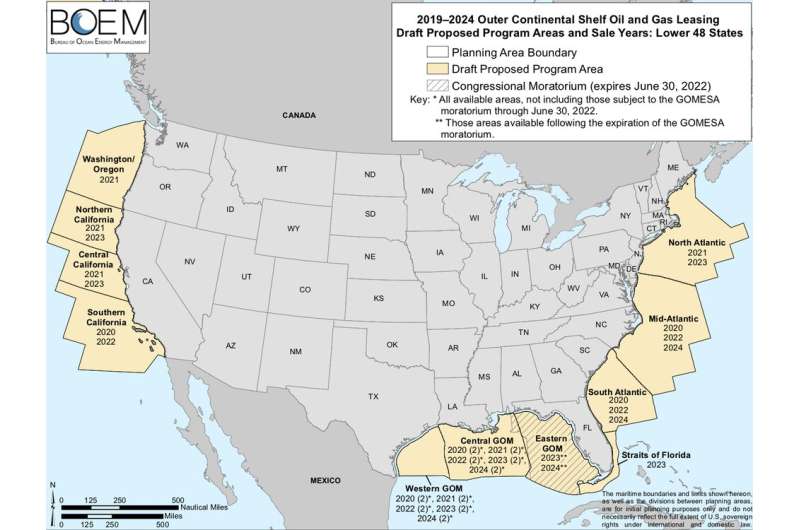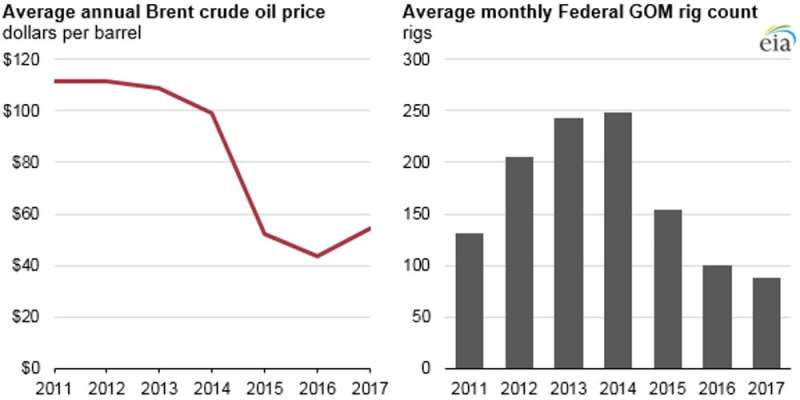Trump offshore drilling plan may be dead in the water, but there are better ways to lead on energy

President Trump's effort to expand offshore oil and gas exploration has stalled, and may be dead in the water. The newest obstacle is an April ruling in Alaska's U.S. District Court that blocked Trump's order to lift a ban on energy leasing in Arctic waters.
Trump's opening nearly all U.S. coastal waters to offshore drilling is now in limbo, and . If Trump is voted out in 2020, the plan won't survive. And even if he is reelected, there are logical arguments for shelving it.
In my view, this proposal has always been more political than practical. What's more, there is plenty of accessible oil and gas on land – as well as renewable energy resources that would do much more to advance Trump's "energy dominance" doctrine.
Offshore drilling is a political loser
Unlike the boom in production on land, which is popular in energy-rich states, expanding offshore leasing and drilling has met almost unbroken resistance. have passed legislation in the past year opposing it. In Florida, where coastal tourism is one of the largest industries, anger at the plan .
The only state where there is strong support for offshore drilling is Alaska, which is highly dependent on oil and gas revenue. Here, though, there has been much onshore and in adjacent state waters.
Republicans fear losing voters in coastal states over this issue in 2020. Recent polls indicate that . Few Americans have forgotten the 2010 BP Deepwater Horizon oil spill and its impacts on tourism, fishing and other coastal industries.
Uncertain gains
Why would Trump even consider such an unpopular move? One driver may be his determination to .
In December 2016, invoking a provision of the 1953 Outer Continental Shelf Lands Act, Obama banned offshore drilling in . Trump sought to kill the ban using an executive order – an approach that reflects his broader effort to . But Alaska's District Court ruled that only Congress can reverse Obama's action.
Nonetheless, the Interior Department is still processing applications to off the Atlantic coast. And the White House is moving to undo new drilling safety requirements adopted .
How much would the oil industry gain from more access to federal waters? Trade groups , but their statements aren't especially convincing – mainly because estimates of potential offshore reserves in the contested areas pale compared to the central and western Gulf of Mexico, where energy companies have been drilling since the late 1930s.
The action is on land
More to the point, an onshore oil and gas boom is underway, centered in several major provinces of the lower 48 states. These areas offer far more potential with much lower drilling costs than the offshore.
Some of the world's largest private oil companies are focused on the , an 86,000 square mile region in West Texas and southeast New Mexico. One measure of the stakes is a Chevron and Occidental over a roughly US$50 billion merger with Anadarko, a company that holds a large and valuable lease position in the basin.

According to and confidential sources I have spoken with, the Permian Basin holds approximately 70-100 billion barrels of oil and over 300 trillion cubic feet of natural gas. In a 2018 study the U.S. Geological Survey for the Delaware Basin, part of the greater Permian Basin province.
These numbers reveal the enormous scale of new resources that have emerged over the past decade from combined use of advanced horizontal drilling and multi-stage hydraulic fracturing. In contrast, estimated reserves in the offshore areas Trump wants to open : Only 5 billion barrels of oil and 38 trillion cubic feet of natural gas for the entire Atlantic seaboard, with perhaps another 13 billion barrels and 50 trillion cubic feet combined for the Eastern Gulf of Mexico and offshore California.
These volumes aren't trivial, but they are likely to be spread over millions of acres. And oil prices, which recently have ranged from about $55-75 per barrel, would need to be much higher to generate any solid interest in such areas.
Perhaps the biggest benefit for the oil industry from expanding offshore leasing would be defeating environmentalists on a signature issue. That could make it easier to open other areas that currently are off-limits to drilling.
This is what the Trump administration is trying to do with the coastal plain portion of the Arctic National Wildlife Refuge, or ANWR, where it is as soon as late 2019. Sometimes called "America's Serengeti," ANWR has been a key battleground for the environmental community since the 1970s. It is hard not to conclude that politics and symbolism are powerful motives for pushing to drill in ANWR and offshore.
A backward-facing vision
President Trump has justified expanding oil and gas production in pursuit of "energy dominance," which in my view means two things: achieving the elusive goal of "energy independence," and restoring the United States as the world's fossil fuel colossus. Our country last held that position in the first half of the 20th century, when the U.S. coal industry was thriving and American oil companies controlled enough of the global supply to set prices and power the Allies to victory in World War II.
But then Saudi Arabia, OPEC and post-Soviet Russia became massive oil and gas producers. And now climate change is . In short, the Trump administration's definition of energy success reflects the America that existed a century ago, not today's conditions.
I believe that any president who wants the United States to play a major role in the world's energy future should be beating the drum for other sources. Fossil fuels will not disappear soon, but low-carbon and carbon-free sources will become ever more essential. And strategies like maximizing offshore oil production will be ever more difficult to justify politically, economically or scientifically.
Provided by The Conversation


















